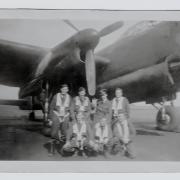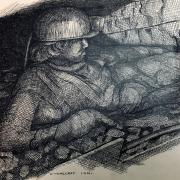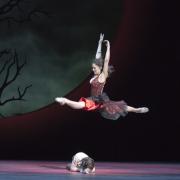Considered by many as the greatest goal-scorer to grace the English game, never once booked or sent off, Dixie Dean was a life-long Toffee, from his Cheshire boyhood till the day he died after watching a game at Goodison.

Less than10 minutes remained for history to be made. The result of the season’s final game versus Arsenal mattered little, for Everton had clinched the 1927-28 League title. All eyes though were fixed on their centre-forward, ‘Dixie’ Dean. Could he break the record for most goals scored in a League season? Everton had a corner as the game approached its embers. Dean stormed in for a trademark header...
William Ralph Dean was born at 313 Laird Street, Birkenhead, on 22nd January 1907 with both sides of his family, William senior’s, and Sarah’s, hailing from Chester. One familial claim to fame was his grandfather Ralph Brett driving the royal train during George V’s reign. Dixie, as William became known, grew up supporting Everton FC, thanks to his father, who took him to Goodison Park during the club’s Championship-winning season of 1914-15. When Everton next won the League Dean would be in the side.

Young Dean taught himself to head by utilising a slanting roof, chucking the ball up there, then flexing his neck muscles as it descended and propelling it against a ‘goal’ daubed on a wall. A physically strong player, Dean maintained this prowess was achieved not by working out but by lugging milk crates around Birkenhead. Between the ages of seven and 11, he delivered cow’s milk to local families during WW1. He attended Laird Street School, then Albert (Memorial) Industrial School: ‘My only lesson was football,’ he said.
Leaving school at 14, Dean began full-time work with Wirral Railway as an apprentice fitter. Railway work ran in the family. As well as that illustrious grandad, William’s dad also earned a living as a train driver.
Dixie was also playing football, including for local club Pensby United, where he was spotted by the local professional club, Tranmere Rovers, joining them in November 1923, aged 16. A relatively brief Tranmere career saw Dean find the back of net 27 times in 30 matches so a bigger club came in. Dean was duly transferred to Everton, the side he’d supported from childhood, for £3,000 in March 1925, a record for a Division Three player. He’d not long turned 18.
How William came to be ‘Dixie’ remains a mystery, although it’s said the man himself wasn’t keen. It’s a moniker that’s often applied to Richard (Dick) rather than William (Bill). However it came about, Dixie’s Everton career would be stellar, as he scored on 350 occasions in just 400 appearances. It’s a strike rate modern goal-scorers can only dream about.
We must focus on 60 of those goals though. The 1926-27 season had seen George Camsell score 59 League goals for Middlesbrough, setting a new record for a season. That had been in Division Two though. Surely that figure couldn’t be surpassed and certainly not in Division One.
I doubt Dean set out to beat Camsell’s record during the following season. Football is a team game and his focus was on winning matches and Everton the title. Come that final game though he had accumulated 57, so needed a brace to tie the record and a hat-trick to surpass it. Dean had two in double-quick time, so it was all about whether he could get another.
Time was ebbing away when Everton won that corner. The ball thwacked off Dean’s head in typical fashion. Goodison Park erupted.
Dean scored 60 in 39 matches, a record that will never be beaten. He was aged just 21. From 1923 to 1939 Dean scored a total of 473 goals in 502 matches (League, FA Cup, representative and international matches). That 1927-28 season was one of two when he was the League’s top scorer, the other being 1931-32. On both occasions Dean’s exploits propelled Everton to the championship.

Dean gained another accolade in 1933 when he became the first ‘Number 9’ at Wembley. The FA chose that year’s Cup Final between Everton and Manchester City to trial shirt numbering. Everton got numbers 1-11 and City 12-22. Dean, who scored in Everton’s 3-0 win, was the first proud wearer of an iconic Number 9 shirt at the old Twin Towers. Bill Shankly, a Red from across Stanley Park, could turn a phrase or two. He said that Dean was ‘the greatest centre-forward there will ever be’ and compared him in typically lyrical fashion to Shakespeare, Beethoven and Rembrandt.
Dean’s England career was short but explosive as he scored 18 goals in just 16 appearances. He should, of course, have played more but the national team’s selection was via a blazered committee that collectively knew as much about football as the average concert party.
Dean was arguably the greatest goal-scorer to grace the English game and is a shoo-in as Everton’s greatest-ever player. That he should have played more often for his country is undeniable. Arsenal, a club that would dominate the 1930s, tried to tempt Everton to part with him, but their blank cheque was refused. Dixie wasn’t interested anyway. In an age before stratospheric TV-fuelled wages, Dean once said: ‘I’d have played for Everton for nothing’.
Dean, a man who headed a ball with prodigious power, must have suffered with those heavy lace-ups that were painful to head if the laces came into contact with your bonce. He wasn’t that tall for a centre-forward either – five feet 10½ –, but what he lacked in height he made up for in anticipation, fearlessness and the proverbial salmon’s leap: it was reported he could jump on to a billiard table from a standing position. Manchester United manager Matt Busby reckoned him the ‘greatest ever practitioner of the heading art’.
He was a player with a lion’s courage and never flinched, which perhaps explains how he underwent 15 operations. Not all his injuries were football-related. In 1926 he fractured his skull, knee and jawbone in a motorcycle accident. He was told he would never play again, but this was Dixie Dean. He was back with the reserves four months later.
His career was cut short though by the game’s physical demands and by the onset of WW2. He’d already left Everton by then. His replacement, signed in 1936, boarded a bus in Liverpool and was spotted by the conductor. Any satisfaction at being recognised was soon dissipated: ‘You’ll never be as good as Dixie’ he was told.

Dean was adored by the fans and not just because of his goal scoring. It was a different game then. He didn’t turn up at home games in an armoured personnel carrier replete with privacy glass, he strolled the short distance from his clubhouse and mingled with fans, happily chatting and signing autographs.
The 1930s was a time of hardship for many and it was a regular occurrence for Dean to purchase tickets for the unemployed. He was a sportsman in every way; never once booked or sent off. Dixie Dean departed Everton, played a few games for Notts County and finally hung up his boots after a couple of games for Hurst (now Ashton United), a Cheshire County League side, in the 1939-40 season.

Dean died in the best possible manner and the most appropriate place. He’d just finished watching his beloved Everton play Liverpool in the Merseyside derby at Goodison Park on 1st March 1980. He was 73. A statue of Dean was unveiled at the ground in 2001, based on a famous photograph of him taking the field in 1927 to play Arsenal, ball in hand, all collars and concentration, while the Grade II listed Dixie Dean Hotel in Liverpool ‘celebrates the amazing story of the Boy from Birkenhead’.
CHRONOLOGY
1907 – Birth of William Ralph Dean in Birkenhead, Cheshire (22nd January).
1923 – Dean signs for his local professional club, Tranmere Rovers FC.
1925 – A move follows to the club he supported from childhood, Everton FC.
1927 – Dixie Dean makes his debut for the full England side.
1928 – Dean scores 60 goals in an English League season, breaking the record of 59.
1931 – Marriage of Dixie Dean and Ethel Fossard (until 1974). They have four children.
1932 – Dixie Dean is the Division 1 top scorer again as Everton win the League once more.
1933 – Dean scores in the FA Cup Final as Everton beat Manchester City 3-0.
1937 – Dean’s last match for Everton is followed by a brief spell at Notts County (1938-39).
1980 – Death of Dixie Dean at Goodison Park, Everton, aged 73 (1st March).



























